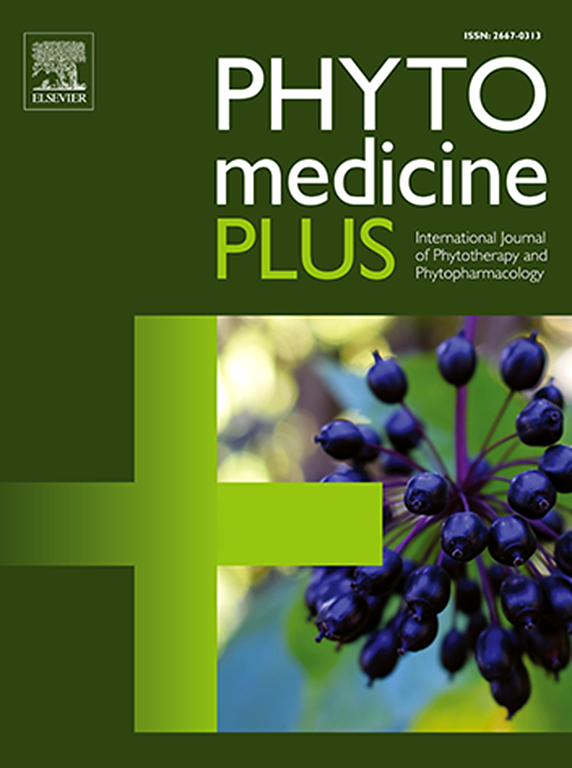黄缕草(Terminalia citrina)的启示Roxb。前弗莱明抑制多重耐药鲍曼不动杆菌
Q3 Pharmacology, Toxicology and Pharmaceutics
引用次数: 0
摘要
印度东北部地区以其丰富的生物多样性和独特的植物群而闻名,其中包括许多尚未研究药用特性的植物。黄毒藤是一种药用植物,传统上用于治疗慢性发热、食欲不振、腹泻、哮喘、煮沸、头晕、痔疮、贫血、眼疾和感染。本研究强调了黄皮霉对脓毒症致病菌(特别是鲍曼不动杆菌)具有抗菌活性的潜在生物活性化合物,并介绍了在动物模型上进行的毒性研究。目的验证传统药用植物治疗微生物感染的有效性,并在动物模型上评估其毒性。收集柑橘属植物物种,并评估其对脓毒症引起的耐多药病原体鲍曼不动杆菌、肺炎克雷伯菌和大肠杆菌的抗菌活性。采用液相色谱-质谱法(LC-MS)鉴定其生物活性代谢物。采用MTT法对Caco-2细胞系进行体外细胞毒性评估,然后对BALB/c小鼠进行体内毒性研究。结果柠檬黄粗提物对鲍曼假单胞杆菌AB0014、AB0015和AB0018有抑制作用。LC-MS分析鉴定了柑橘EM2亚段的5种代谢物。MTT试验显示对Caco-2细胞系没有细胞毒性作用。鲍曼不动杆菌AB0014分离物与黄皮不动杆菌EM2亚段浓度为2.82 mg/mL处理后,细胞形态发生改变,细胞萎缩,生长受到抑制。急性和亚急性口服毒性研究显示,黄皮霉(EM2)未出现毒性或行为改变的迹象。在印度曼尼普尔发现的柑橘对耐多药鲍曼尼杆菌临床分离株表现出抗菌活性。黄皮草(EM2)中酚类化合物的存在可能与其抗菌活性有关。黄皮霉活性组分(EM2)可能是开发一种治疗败血症的新药的备选药物。本文章由计算机程序翻译,如有差异,请以英文原文为准。

Insights of Terminalia citrina (Gaertn.) Roxb. Ex Fleming inhibiting multidrug resistant Acinetobacter baumannii
Background
The Northeast region of India is renowned for its rich biodiversity and unique flora, including many plants with unstudied medicinal properties. Terminalia citrina is a medicinal plant traditionally used to treat chronic fever, loss of appetite, diarrhoea, asthma, boils, dizziness, haemorrhoids, anaemia, eye diseases, and infections. This study highlights potential bioactive compounds of T. citrina with antimicrobial activity against sepsis-causing pathogens, specifically Acinetobacter baumannii isolates, and presents the toxicity studies conducted on an animal model.
Purpose
The study focused on validating the traditional use of medicinal plants for treating microbial infections and assessing their toxicity in an animal model.
Methods
T. citrina plant species were collected and evaluated for antimicrobial activity against sepsis causing MDR pathogens Acinetobacter baumannii, Klebsiella pneumoniae, and Escherichia coli. The bioactive metabolites were identified using liquid chromatography–mass spectrometry (LC-MS). The in-vitro cytotoxicity of the active fraction was assessed using the MTT assay on the Caco-2 cell line followed by in-vivo toxicity study in BALB/c mice.
Results
The crude extract of T. citrina, obtained using a hydroalcoholic solvent, inhibited the growth of A. baumannii isolates AB0014, AB0015, and AB0018. LC-MS analysis identified five metabolites in the EM2 subfraction of T. citrina. The MTT assay demonstrated no cytotoxic effects on the Caco-2 cell line. Treatment of A. baumannii isolate AB0014 with the EM2 subfraction of T. citrina at 2.82 mg/mL altered cellular morphology, causing cell shrinkage and growth inhibition. Acute and subacute oral toxicity studies of T. citrina (EM2) showed no signs of toxicity or behavioural changes.
Conclusion
T. citrina found in Manipur, India, exhibited antimicrobial activity on MDR A. baumannii clinical isolates. The presence of phenolic compounds -in T. citrina (EM2) may be attributed to the antimicrobial activity. The T. citrina active fraction (EM2) may be an alternative candidate for developing a new drug for managing sepsis.
求助全文
通过发布文献求助,成功后即可免费获取论文全文。
去求助
来源期刊

Phytomedicine Plus
Medicine-Complementary and Alternative Medicine
CiteScore
3.70
自引率
0.00%
发文量
178
审稿时长
81 days
期刊介绍:
 求助内容:
求助内容: 应助结果提醒方式:
应助结果提醒方式:


